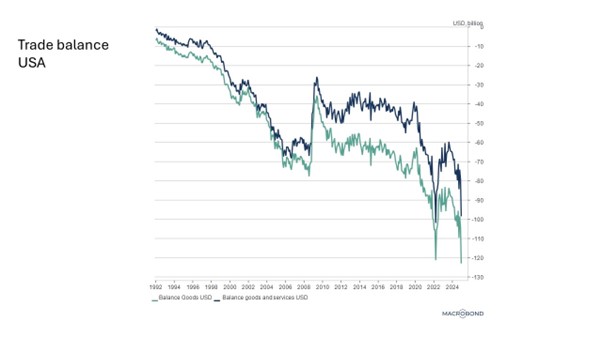Trade deficit: the reasons for anger
2 min
The entire world is watching the tariffs imposed by Donald Trump, trying to measure their impact on growth and global trade dynamics. Concern is growing in many sectors as the threat of retaliation raises fears of a much less stable 2025 than expected.
The massive US trade deficit has been a part of the election campaign from the start, and the announcement of tariffs against China, Mexico, and Canada was made in the early hours of Trump's second term. Since then, some horse trading has taken place (lower taxes in exchange for better border surveillance), but not for products from China. It's worth noting that the recent publication of 2024 figures must have comforted the American president: the US trade deficit (in goods and services) exploded in 2024, up 17% from the previous year, to $918 billion, the worst result of all time, except for 2022. Part of the deficit explosion in the last months of the year was because American companies wanted to anticipate the tariffs and import more than necessary before their introduction. In December alone, the deficit in goods trade reached $122 billion, bringing the total for the year to a record high of $1.211 billion. Compared to the result of October (before Trump's victory), the deficit worsened by 24%! If we exclude oil transactions, which recorded a surplus of $44 billion in 2024, the US trade balance showed a hole of almost $1.250 billion in 2024!
Globalisation is reshuffling the cards
The reality of this structural deterioration of the US trade balance over the past 30 years lies in globalisation, the desire to produce at ever-lower costs, and, therefore, to relocate the production of an increasing number of goods to where labour is cheaper and environmental regulations are less stringent. Over time, the US has lost its first place in global manufacturing production to the benefit of China, which now produces over 31% of the total, compared to 15% for the US.
Donald Trump's obsession is to reduce this deficit, particularly the bilateral deficit with China. In 2024, this deficit worsened by 6%, to $295 billion. We also know that this trade deficit is even higher because some US imports have been routed through other countries, particularly Vietnam and Mexico, to circumvent the tariffs imposed on goods from China since 2018.
The world is changing
The proof of the magnitude of this phenomenon is that Vietnam is now the country with which the US records the third-largest trade deficit, at $123 billion, just behind China and Mexico. In 2024 alone, this represents a worsening of 18%. Remember that before 2019, Vietnam was an utterly anecdotal player in trade with the US.
Tariffs have not finished making headlines and reshaping the world.


